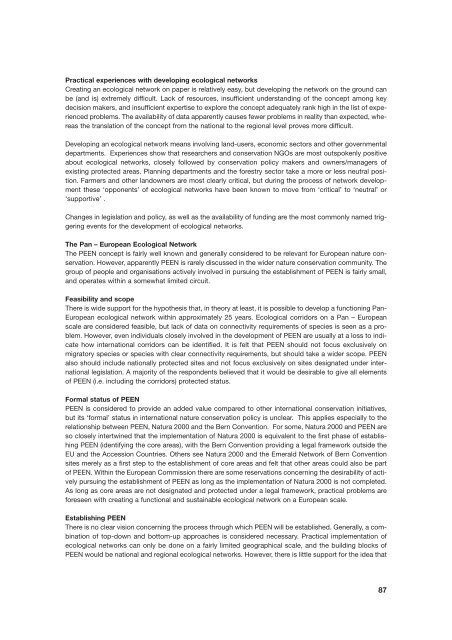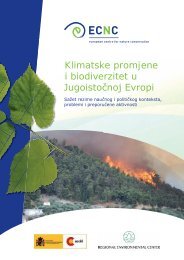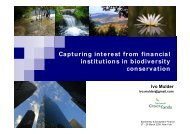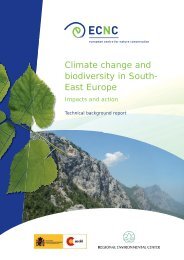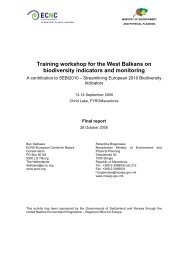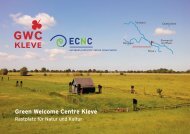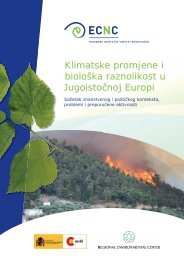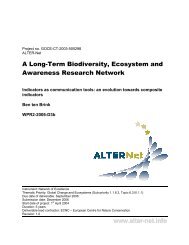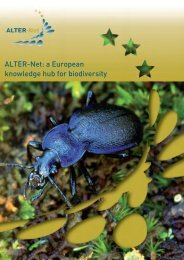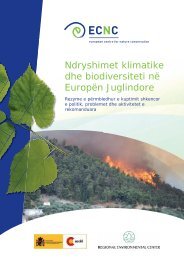2005 - Communicating the Pan-European Ecological Network - ECNC
2005 - Communicating the Pan-European Ecological Network - ECNC
2005 - Communicating the Pan-European Ecological Network - ECNC
You also want an ePaper? Increase the reach of your titles
YUMPU automatically turns print PDFs into web optimized ePapers that Google loves.
Practical experiences with developing ecological networksCreating an ecological network on paper is relatively easy, but developing <strong>the</strong> network on <strong>the</strong> ground canbe (and is) extremely difficult. Lack of resources, insufficient understanding of <strong>the</strong> concept among keydecision makers, and insufficient expertise to explore <strong>the</strong> concept adequately rank high in <strong>the</strong> list of experiencedproblems. The availability of data apparently causes fewer problems in reality than expected, whereas<strong>the</strong> translation of <strong>the</strong> concept from <strong>the</strong> national to <strong>the</strong> regional level proves more difficult.Developing an ecological network means involving land-users, economic sectors and o<strong>the</strong>r governmentaldepartments. Experiences show that researchers and conservation NGOs are most outspokenly positiveabout ecological networks, closely followed by conservation policy makers and owners/managers ofexisting protected areas. Planning departments and <strong>the</strong> forestry sector take a more or less neutral position.Farmers and o<strong>the</strong>r landowners are most clearly critical, but during <strong>the</strong> process of network development<strong>the</strong>se ‘opponents’ of ecological networks have been known to move from ‘critical’ to ‘neutral’ or‘supportive’ .Changes in legislation and policy, as well as <strong>the</strong> availability of funding are <strong>the</strong> most commonly named triggeringevents for <strong>the</strong> development of ecological networks.The <strong>Pan</strong> – <strong>European</strong> <strong>Ecological</strong> <strong>Network</strong>The PEEN concept is fairly well known and generally considered to be relevant for <strong>European</strong> nature conservation.However, apparently PEEN is rarely discussed in <strong>the</strong> wider nature conservation community. Thegroup of people and organisations actively involved in pursuing <strong>the</strong> establishment of PEEN is fairly small,and operates within a somewhat limited circuit.Feasibility and scopeThere is wide support for <strong>the</strong> hypo<strong>the</strong>sis that, in <strong>the</strong>ory at least, it is possible to develop a functioning <strong>Pan</strong>-<strong>European</strong> ecological network within approximately 25 years. <strong>Ecological</strong> corridors on a <strong>Pan</strong> – <strong>European</strong>scale are considered feasible, but lack of data on connectivity requirements of species is seen as a problem.However, even individuals closely involved in <strong>the</strong> development of PEEN are usually at a loss to indicatehow international corridors can be identified. It is felt that PEEN should not focus exclusively onmigratory species or species with clear connectivity requirements, but should take a wider scope. PEENalso should include nationally protected sites and not focus exclusively on sites designated under internationallegislation. A majority of <strong>the</strong> respondents believed that it would be desirable to give all elementsof PEEN (i.e. including <strong>the</strong> corridors) protected status.Formal status of PEENPEEN is considered to provide an added value compared to o<strong>the</strong>r international conservation initiatives,but its ‘formal’ status in international nature conservation policy is unclear. This applies especially to <strong>the</strong>relationship between PEEN, Natura 2000 and <strong>the</strong> Bern Convention. For some, Natura 2000 and PEEN areso closely intertwined that <strong>the</strong> implementation of Natura 2000 is equivalent to <strong>the</strong> first phase of establishingPEEN (identifying <strong>the</strong> core areas), with <strong>the</strong> Bern Convention providing a legal framework outside <strong>the</strong>EU and <strong>the</strong> Accession Countries. O<strong>the</strong>rs see Natura 2000 and <strong>the</strong> Emerald <strong>Network</strong> of Bern Conventionsites merely as a first step to <strong>the</strong> establishment of core areas and felt that o<strong>the</strong>r areas could also be partof PEEN. Within <strong>the</strong> <strong>European</strong> Commission <strong>the</strong>re are some reservations concerning <strong>the</strong> desirability of activelypursuing <strong>the</strong> establishment of PEEN as long as <strong>the</strong> implementation of Natura 2000 is not completed.As long as core areas are not designated and protected under a legal framework, practical problems areforeseen with creating a functional and sustainable ecological network on a <strong>European</strong> scale.Establishing PEENThere is no clear vision concerning <strong>the</strong> process through which PEEN will be established. Generally, a combinationof top-down and bottom-up approaches is considered necessary. Practical implementation ofecological networks can only be done on a fairly limited geographical scale, and <strong>the</strong> building blocks ofPEEN would be national and regional ecological networks. However, <strong>the</strong>re is little support for <strong>the</strong> idea that87


